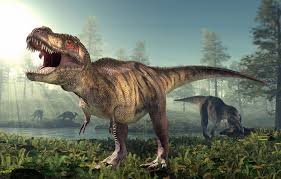Dinosaurs, a group of reptiles that dominated the Earth for over 160 million years, have captivated human imagination for centuries. Their history is a complex narrative that spans several geological periods, marked by dramatic evolutionary changes and culminating in a mass extinction event that reshaped life on Earth.
Origins and Early Evolution
Triassic Period (approximately 252 to 201 million years ago)
The story of dinosaurs begins in the Triassic period, following the Permian-Triassic extinction event, which wiped out nearly 90% of Earth’s species. This mass extinction paved the way for new life forms to evolve. The first dinosaurs appeared around 230 million years ago during the middle to late Triassic period. Early dinosaurs were small, bipedal, and swift predators or omnivores. Some of the earliest known dinosaurs include Eoraptor, Herrerasaurus, and Staurikosaurus.
Dinosaurs quickly diversified and spread across the continents, which were joined together in the supercontinent Pangaea. Their ability to walk upright on two legs (bipedalism) gave them an advantage over other reptiles, allowing them to become efficient hunters and foragers.
Jurassic Period (approximately 201 to 145 million years ago)
The Jurassic period marked the golden age of dinosaurs. As Pangaea began to break apart, creating new coastlines and varied climates, dinosaurs adapted to these changing environments. This period saw the rise of some of the most iconic dinosaur species.
Sauropods
Sauropods, such as Brachiosaurus and Diplodocus, were gigantic herbivorous dinosaurs known for their long necks and tails. They roamed the land in herds, feeding on the abundant vegetation. These massive creatures were some of the largest animals to ever walk the Earth.
Theropods
Theropods, a group of bipedal carnivores, also thrived during the Jurassic. This group included the fearsome Allosaurus and the smaller but agile Velociraptor. Theropods were diverse in size and diet, ranging from large apex predators to smaller, feathered species that likely gave rise to birds.
Ornithischians
Ornithischian dinosaurs, such as Stegosaurus and Ankylosaurus, were primarily herbivores. They developed various adaptations for defense, including armored plates and clubbed tails. These adaptations helped them survive in a world filled with predators.
Cretaceous Period (approximately 145 to 66 million years ago)
The Cretaceous period was a time of further diversification and the peak of dinosaur dominance. By this time, the continents had largely drifted to their present positions, creating isolated environments where dinosaurs continued to evolve in unique ways.
Tyrannosaurs and Ceratopsians
The Cretaceous saw the emergence of the formidable tyrannosaurs, including the famous Tyrannosaurus rex. These massive predators were apex hunters with powerful jaws and keen senses. Alongside them, ceratopsians like Triceratops developed large frills and horns, which were used for defense and possibly display.
Hadrosaurs and Ankylosaurs
Hadrosaurs, or duck-billed dinosaurs, were widespread herbivores known for their advanced chewing mechanisms. Ankylosaurs, on the other hand, were heavily armored dinosaurs with tail clubs, providing protection against predators.
Feathered Dinosaurs and the Origin of Birds
One of the most significant discoveries in recent paleontology is the presence of feathers in many theropod dinosaurs. These findings have bridged the gap between non-avian dinosaurs and birds. The small, feathered dinosaur Archaeopteryx, from the late Jurassic, is often cited as a transitional species, showcasing features of both dinosaurs and birds.
Extinction Event
Around 66 million years ago, the reign of the dinosaurs came to an abrupt end. The Cretaceous-Paleogene (K-Pg) extinction event, often attributed to a massive asteroid impact near present-day Yucatán Peninsula in Mexico, caused dramatic changes to the Earth’s climate and environment. This event led to the extinction of approximately 75% of all species on Earth, including all non-avian dinosaurs.
The impact would have caused immediate destruction through a massive explosion, fires, and tsunamis, followed by a “nuclear winter” effect, where dust and debris blocked sunlight, drastically cooling the planet. The loss of sunlight would have disrupted photosynthesis, leading to the collapse of food chains.
Legacy of Dinosaurs
While non-avian dinosaurs became extinct, their legacy lives on through their avian descendants—birds. Modern birds are considered the only surviving dinosaurs, carrying forward many traits of their ancestors. This connection is a testament to the adaptability and resilience of these creatures.
Dinosaurs have also left an indelible mark on human culture and science. The study of dinosaurs, known as paleontology, has provided valuable insights into evolution, extinction, and Earth’s geological history. Fossil discoveries continue to captivate scientists and the public alike, offering glimpses into a world that existed millions of years before humans.
In popular culture, dinosaurs have achieved iconic status, inspiring countless books, films, and other media. From the terrifying Tyrannosaurus rex in “Jurassic Park” to the gentle Brachiosaurus in children’s stories, dinosaurs have become a symbol of the prehistoric past and a source of endless fascination.
In conclusion, the history of dinosaurs is a saga of rise and fall, adaptation and extinction. Their dominance over the Mesozoic era, their dramatic end, and their lasting legacy through birds provide a powerful narrative of life’s dynamic and ever-changing nature on our planet.



